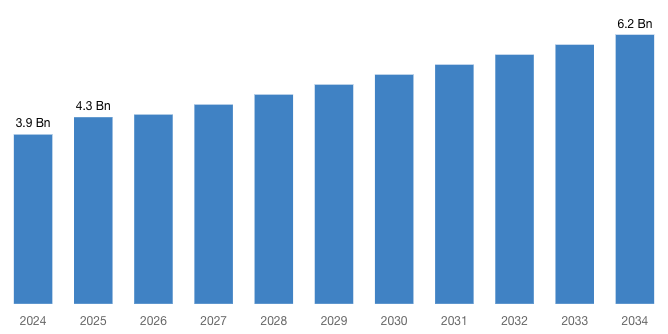Austin, TX, USA, Aug. 07, 2025 (GLOBE NEWSWIRE) — Custom Market Insights has published a new research report titled “Agricultural Adjuvants Market Size, Trends and Insights By Product (Activator Adjuvants, Utility Adjuvants), By Application (Herbicides, Insecticides, Fungicides, Others), By Source (Petroleum-based, Bio-based), By Formulation (Oil-based, Others), By Crop Type (Organic, Conventional), and By Region – Global Industry Overview, Statistical Data, Competitive Analysis, Share, Outlook, and Forecast 2025–2034“ in its research database.
“According to the latest research study, the demand of the global Agricultural Adjuvants Market size & share was valued at approximately USD 3.9 Billion in 2024 and is expected to reach USD 4.3 Billion in 2025 and is expected to reach a value of around USD 6.2 Billion by 2034, at a compound annual growth rate (CAGR) of about 4.78% during the forecast period 2025 to 2034.”
Click Here to Access a Free Sample Report of the Global Agricultural Adjuvants Market @ https://www.custommarketinsights.com/request-for-free-sample/?reportid=17984
Agricultural Adjuvants Market: Overview
According to industry experts at CMI, agricultural adjuvants are chemicals that are added to pesticides, herbicides, insecticides, and fungicides to improve their performance. They can be added to a product when it’s purchased or mixed in before application.
The agriculture adjuvants industry is being driven by several factors such as the increasing agriculture sector, increasing spreading of insecticides in agricultural land, growing product launches, and increasing focus on sustainable practices. However, the lack of awareness among farmers and environmental concerns pose a major challenge to the industry’s growth.
Request a Customized Copy of the Agricultural Adjuvants Market Report @ https://www.custommarketinsights.com/request-for-customization/?reportid=17984
Agricultural Adjuvants Market: Growth Factors and Dynamics
Growing population
One of the major factors that will lead to the growth of the agricultural adjuvants market is the increasing population of various nations across the world. The increasing population creates more demand for food and this shall lead to an increase in the demand for agricultural adjuvants in the forecast period. In the previous ten decades, the population of the world has increased fourfold, and it will soon grow to 9.2 billion by the year 2050.
Rising investment in R&D
Increased investments in agricultural research and development (R&D) are having a positive impact on the market. These expenditures are resulting in the creation of novel adjuvant compositions with enhanced functions and performance. New adjuvants are being developed through substantial R&D efforts to improve agrochemical compatibility, stability, and efficiency.
AAdvanced formulations address concerns of farmers, including increased pesticide resistance and the need for fewer chemical inputs. According to the Department of Agriculture, Fisheries and Forestry, rising investments in agricultural R&D in Australia, totaling USD 2.98 billion in 2023-24 with 6.85% annual private sector growth, will drive innovations in agricultural adjuvants, improving crop protection and productivity while reducing environmental impacts.
High cost of adjuvants
The agricultural adjuvants market is restrained by its high cost. The high cost of agricultural adjuvants negatively impacts adoption rate, particularly among budget conscious farmers. PProduction costs increase due to manufacturers’ substantial investments in research and development aimed at creating advanced, multipurpose adjuvants, including bio-based or environmentally friendly options. High-performance adjuvants are often expensive because of the usage of high cost of raw materials such as polymers, surfactants, or refined oils.
Report Scope
| Feature of the Report | Details |
| Market Size in 2025 | USD 4.3 Billion |
| Projected Market Size in 2034 | USD 6.2 Billion |
| Market Size in 2024 | USD 3.9 Billion |
| CAGR Growth Rate | 4.78% CAGR |
| Base Year | 2024 |
| Forecast Period | 2025-2034 |
| Key Segment | By Product, Application, Source, Formulation, Crop Type and Region |
| Report Coverage | Revenue Estimation and Forecast, Company Profile, Competitive Landscape, Growth Factors and Recent Trends |

